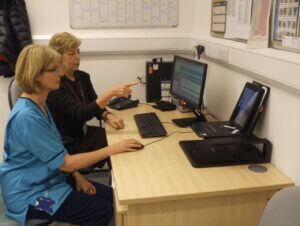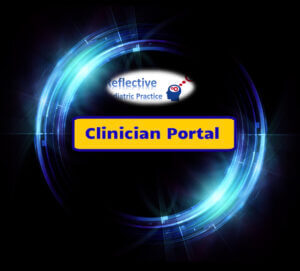Are Podiatry On-Line Consultations a Good Idea?
 The question Are podiatry on-line consultations a good idea? has not as yet had any great impact in our own press. Peter Russell posted his take on the ‘Remote GP‘ in a recent Medscape article (2021). As reports have concerns about the impact on GP practices. What do the two main organisations think? Is there enough data to reflect on performance to date in podiatry? Has Covid-19 made a difference to our attitudes?
The question Are podiatry on-line consultations a good idea? has not as yet had any great impact in our own press. Peter Russell posted his take on the ‘Remote GP‘ in a recent Medscape article (2021). As reports have concerns about the impact on GP practices. What do the two main organisations think? Is there enough data to reflect on performance to date in podiatry? Has Covid-19 made a difference to our attitudes?
If these questions cannot be answered perhaps we can draw upon activities from other practices. This article follows on from my article providing advice – Giving advice on-line as a podiatrist. The term video-conferencing (VC) is used specifically as part of tele-medicine and on-line consultations.
Of course on-line consultations might bring a range of different interpretation but we are really only at a technological junction where choosing tele-medicine over face to face contact is being raised for different purposes. Direct interfacing between two people forms the basis of VC and here many will be familiar with the benefits of ZOOM or MICROSOFT TEAMS. Tele-medicine is not new. Surgeons and specialists have used different forms for many decades. Consulting over patient images and results of tests has been common. As technology has improved so have the opportunities that tele-medicine brings.
“Between March and July [2020], NHS Digital estimated there were 102 million GP appointments, half of which were recorded as being over the phone or through video calls,’ writes Peter Russell.”
Exploring on-line podiatry
foot health providers are not automatically sign-posted
 I wanted to look at the subject to raise the idea that there might be a place for VC in podiatry. Would it be called tele-podiatry? It might be useful to look at the subject from a broad perspective. The precedent arises all the while access to the GP surgery provides a risk. This limits face to face contact with the GP. At present applying online, phoning the surgery or contacting NHS111 all exist. The problem with NHS 111 (before the pandemic) was that ‘foot conditions’ tended to be referred back to the GP. The main arena where recognition of good practice around foothealth is encompassed around the diabetic patient. Other areas of foot health don’t appear to be recognised and NHS111 will almost certainly use any other referral resource other than podiatry. And so it would appear that podiatry as first line foot health providers are not automatically sign-posted.
I wanted to look at the subject to raise the idea that there might be a place for VC in podiatry. Would it be called tele-podiatry? It might be useful to look at the subject from a broad perspective. The precedent arises all the while access to the GP surgery provides a risk. This limits face to face contact with the GP. At present applying online, phoning the surgery or contacting NHS111 all exist. The problem with NHS 111 (before the pandemic) was that ‘foot conditions’ tended to be referred back to the GP. The main arena where recognition of good practice around foothealth is encompassed around the diabetic patient. Other areas of foot health don’t appear to be recognised and NHS111 will almost certainly use any other referral resource other than podiatry. And so it would appear that podiatry as first line foot health providers are not automatically sign-posted.
The Telephone
 Telephone consultations have certainly increased. As a patient I have participated in a skin assessment using photos I uploaded from my iPhone after speaking to a doctor. I went through the reception triage process first, then the GP phoned back. See my article for a lesion on my wrist. Speaking to a colleague before COVID, his view was certainly cool in responding positively about his ‘surgical’ practice and the idea of VC. So are there any positives?
Telephone consultations have certainly increased. As a patient I have participated in a skin assessment using photos I uploaded from my iPhone after speaking to a doctor. I went through the reception triage process first, then the GP phoned back. See my article for a lesion on my wrist. Speaking to a colleague before COVID, his view was certainly cool in responding positively about his ‘surgical’ practice and the idea of VC. So are there any positives?
Changing the shape of healthcare delivery

Fiona Main (Diabetes Specialist Podiatrist) alongside Prof. Sandra MacRury conducting a remote foot consultation with a patient and podiatry colleague in the community.
If you wondered whether telemedicine was here to stay, my interview this month with Sandra MacRury, Professor in Clinical Diabetes and Head of Rural Health & Wellbeing, soon made it clear. Diabetes and podiatry are intimately linked in preventing amputations. “We’ve been running video conferencing consultations in our general diabetes service for many years”.
MacRury and her team have perfected a system whereby patients are visited by professionals, including podiatrists such as Fiona Main. Using portable modems and tablets much of a consultation can be performed from a distance but importantly in the patient’s home. The whole process is designed as an integrated pathway. Visits can be linked back to clinics so that expertise can be offered and any cases, including ulcers can be managed and evaluated following treatment programmes.
“A few years ago we started thinking about how we could really improve equity of access for patients in rural areas with diabetic foot disease.” She points out the huge distances of hundreds of miles away. “It’s quite daunting for older people who don’t have access to services.” It becomes clear that she feels they are only seeing the tip of the iceberg and it comes down to being referred in a timely fashion. When asked about podiatric input she was very positive. As far as satisfaction ratings have been concerned these have come in at 98% for the remote service. For general podiatry and those who may not always deal with diabetic foot problems she believes upskilling and triaging patients using defined tools could be followed up with a VC with a patient in their home.
The Downside
Not everyone buys into the idea of telemedicine. In contrast with the positive overtures brought about by strong evidence in Scotland for well defined areas of medicine, others take a different view. Overall rapport is not established partly because we cannot see each other. Loss of identity and warmth lead to less value than digitised video link. The Royal College of General Practitioners is far from in favour according to Professor Marshall. The loss of confidence or personal relationships can lead from lack of visual empathy. However there are those like Amjad Khan, director of postgraduate GP education for Scotland, who believes that such consultations are likely to stay.
Consultations by ’phone are shorter and cover fewer problems. Even when we could see GPs before Covid, one GP obsessed about only talking about one medical event or episode without an extended appointment. As patients we deemed this poor practice (Tollafield 2020). The question lies with overcoming these perceived weak trends and not seeing them as ‘factory led.’
Dr Roger Neighbour, a former RCGP president, who now lectures on consulting skills and general practice, warned of the dangers of evolving the system to the stage where the starting point was “digital until proven otherwise“. Neighbour considers that “we’re in danger of losing something very important… It behoves the old ones amongst us to make sure that the rising generation really do get to know and experience the reward and the fulfilment of doing face-to-face consultations, because once that’s lost, it’s lost forever.”
Research and making the case
“It’s a skill and communication that podiatry is going to have to learn and develop”
The economic and social research council is part of UK Research and Innovation (UKRI) and is a large organisation looking at research on economic and social issues. Professor Trisha Greenhalgh and a team were awarded to look at the effectiveness of remote care during the COVID-19 pandemic in collaboration with the Nuffield Trust and University of Plymouth. “The thing about medicine is that it is governed not by hard and fast rules [and] standard operating procedures, but by professional maxims or rules of thumb, which apply in some but not all circumstances. But the question is, what are those rules of thumb, and how can we balance stipulating them explicitly, versus leaving scope for the 75% of patients who are exceptions to the textbook case? And that’s precisely what we’re doing research about.” Professor Greenhalgh.
Greenhalgh’s report suggests that video consultations appeared to work better when the clinician and patient already know and trust each other. There were likely to be multiple challenges for embedding virtual consultation in routine practice but there was evidence to suggest that the scene has been set.
I asked Professor Stuart Baird, former Chair of the Royal College of Podiatry (previouslyThe Society of Chiropodists & Podiatrists ‘do you think that telemedicine has a part to play in podiatry?’
“I think most definitely. It’s a skill and communication that podiatry is going to have to learn and develop. The sequence of questioning and not having the patient in front of you is something that we are going to have to teach our undergraduates. Post Covid, remote consultation is not going to go away, there’s a need and a place for it. Triaging the patient, either giving them advice over the phone which will be sufficient, or making the decision that that patient has got to come in to see you, that’s where the skill is and that’s where the clinical decision making has to be made. Can the patient stay at home and have the condition managed remotely or do they need to come into the clinic to see you for a further consultation, and have further diagnostic tests carried out? Personally I think it’s an enormous benefit to us as clinicians and will only enhance our profession.
What do the Formal Organisations for Podiatry say?
Guidelines were issued during the first lockdown. This advice can be found under the ‘membership’ section under ‘Remote Consultations.’ “To date, the College of Podiatry has not surveyed its members on the use of video or online consultations in podiatric practice. We recognise that each area of podiatric speciality has different needs and we have provided our members with a wide range of resources to allow them to practice safely during the pandemic. This includes engaging in telemedicine where deemed appropriate. The College cannot comment on how this compares to the advice issued to any other professions by other organisations.” The Royal College of Podiatry.
“In short, (we) do not have any stats on numbers of video consults. Regarding video consultations our ‘Traffic Light’ system of advice went on our website at the start of the pandemic restrictions last year and was also circulated more than once via our media comm’s channels.” The Institute of Chiropody and Podiatry.
It is probably reasonable to state that a member organisation will only respond to need. Members are trying to keep up with changing guidelines to protect themselves, their staff as well as patients, and yet deliver a front line service. In time debate will arise no doubt with amusement as to how some patients might try to show their feet to a laptop camera or manipulate a tablet to find the right angle and lighting for a snap shot. Video and static photos of course will produce some information but consultations come down to listening, interrogation methods, using the correct subtext to elicit information unambiguously.
 For and Against
For and Against
The arguments for and against will continue to smoulder long after Covid-19 reaches a satisfactory level of control. The fact that all of healthcare will need to look at telemedicine in different ways is inevitable. We must guard against not falling into the trap of losing the importance and reward from face to face consultations. It seems to me that the very best consultation is conducted by visiting a patient in their home. If VC methods can bring this closer to an ideal then we can be assured that it offers benefits. Clinical appointments are more efficient but have been deemed in some medical practices a heavy burden on time and have accordingly been cut back. If we see that telemedicine offers yet another step down in care we will indeed lose something as precious, Dr Neighbour suggests. From such debates as reported we can identify a need to be strategic in any role out.
Guidelines
One very large omission doubtlessly is our lack of training and engagement with the public by the internet interface. Of course the word and software Zoom has reached out to many and so the concept is no longer as strange as once it was. Guidelines are available and these can be applied universally to most patient-clinician situations.
And of those questions asked?
For the moment podiatry has not trodden the formal path of telemedicine but in time external forces might affect the way we do business. Certainly without doubt we do not have sufficient evidence. More discussion will result from information pooled from the experiences of the long pandemic. For many, and especially those in rural areas, healthcare delivery will change in design. The passion Professor MacRury has should inform us that VC is important. At the very least VC can be used to help those who should be seen expeditiously. As a patient and former clinician I accept that a crib sheet set as a telephone triage is not ideal. But VC can bring warmth and assurance to patients. We must balance criticism against trying to improve reflecting upon our learning. Technology will only improve in time.
![]()
Russell, P. The Remote GP Consultation: No Turning Back? – Medscape – Feb 15, 2021.
BMJ. 2020;368:m998. DOI: https://doi.org/10.1136/bmj.m998
General Medical Council. Remote consultations. Available from: https://www.gmcuk.org/ethical-guidance/ethical-hub/remote-consultations
NHSX. Information Governance. Available from: https://www.nhsx.nhs.uk/key-informationand-tools/information-governance- guidance
Health and Care Professions Council (HCPC). Information on providing online services. Available from: https://www.hcpc- uk.org/registration/meeting-our-standards/informationon-providing-online- services/
Main,F, Zubala, A, Gorman, J, Jone, S, Jenny Hall,J, Macfarlane, D and Sandra MacRury, S. Technology-enabled remote management of diabetes foot disease and potential for reduction in associated health costs: a pilot study. Journal of Foot and Ankle Research (2021) 14:7 https://doi.org/10.1186/s13047-020-00444-6
MacRury,S, Stephen,K, Main,F, Gorman,J, Jones,S, Macfarlane,D. Amputations in People with Diabetes (RAPID): Evaluation of a New Care Pathway. Int. J. Environ. Res. Public Health 2018, 15, 999; doi:10.3390/ijerph15050999
Greenhalgh T, Shaw S, Wherton J, et al. Real-World Implementation of Video Outpatient Consultations at Macro, Meso, and Micro Levels: Mixed- Method Study. J Med Internet Res 2018;20(4): e150. Available from: DOI: 10.2196/jmir.9897
 With thanks to Professor Stuart Baird and Professor Sandra MacRury, Fiona Main, The Royal College of Podiatry and the Institute of Chiropodists & Podiatrists, Phil Hendy, Plymouth University for sharing their views. Some of the above references were provided by the Royal College. The idea for this article has been influenced by the recent February 2021 Medscape article ‘No Turning Back’. This has been a podiatric reflective practice article.
With thanks to Professor Stuart Baird and Professor Sandra MacRury, Fiona Main, The Royal College of Podiatry and the Institute of Chiropodists & Podiatrists, Phil Hendy, Plymouth University for sharing their views. Some of the above references were provided by the Royal College. The idea for this article has been influenced by the recent February 2021 Medscape article ‘No Turning Back’. This has been a podiatric reflective practice article.
Thanks for reading ‘Are Podiatry On-Line Consultations a Good Idea?’ by David R Tollafield
Published by Busypencilcase Reflective Communications Est. 2015

Why not stay in touch and sign up to my regular newsfeed

Launched 31 March 2021

Telemedicine is an excellent option available for families who live in locations where it is difficult to access in-person care for children. It is also an urgent care solution outside of office hours when most pediatric offices are not open or when a middle-of-the-night drive is not a realistic option. Editors note: I am sure this is valuable for pediatrics but of course, this site deal with podiatric foot health and so consultingfootpain cannot comment on children per se. This comment is to ensure people do not confuse two titles which are different although podiatrists do deal with children.